Alabaster has become a go-to exterior color for homes because of its soft warmth and timeless appeal. It works well as a neutral backdrop, allowing accent colors and architectural details to stand out without overwhelming the design. The best way to elevate an alabaster house is by pairing it with the right color scheme that enhances curb appeal and creates balance.
Different combinations can completely change the character of an alabaster home. A dark slate roof can add contrast and refinement, while navy shutters introduce depth and a classic touch. Brick foundations, tan roofing, or green shutters each bring their own personality, showing how versatile alabaster can be.
By exploring five distinct color schemes, this guide highlights practical ways to make an alabaster house feel polished, inviting, and visually cohesive. Each scheme focuses on simple, achievable pairings that strengthen curb appeal without relying on dramatic or trendy choices.
Slate Roof And Wet Pavement Charm
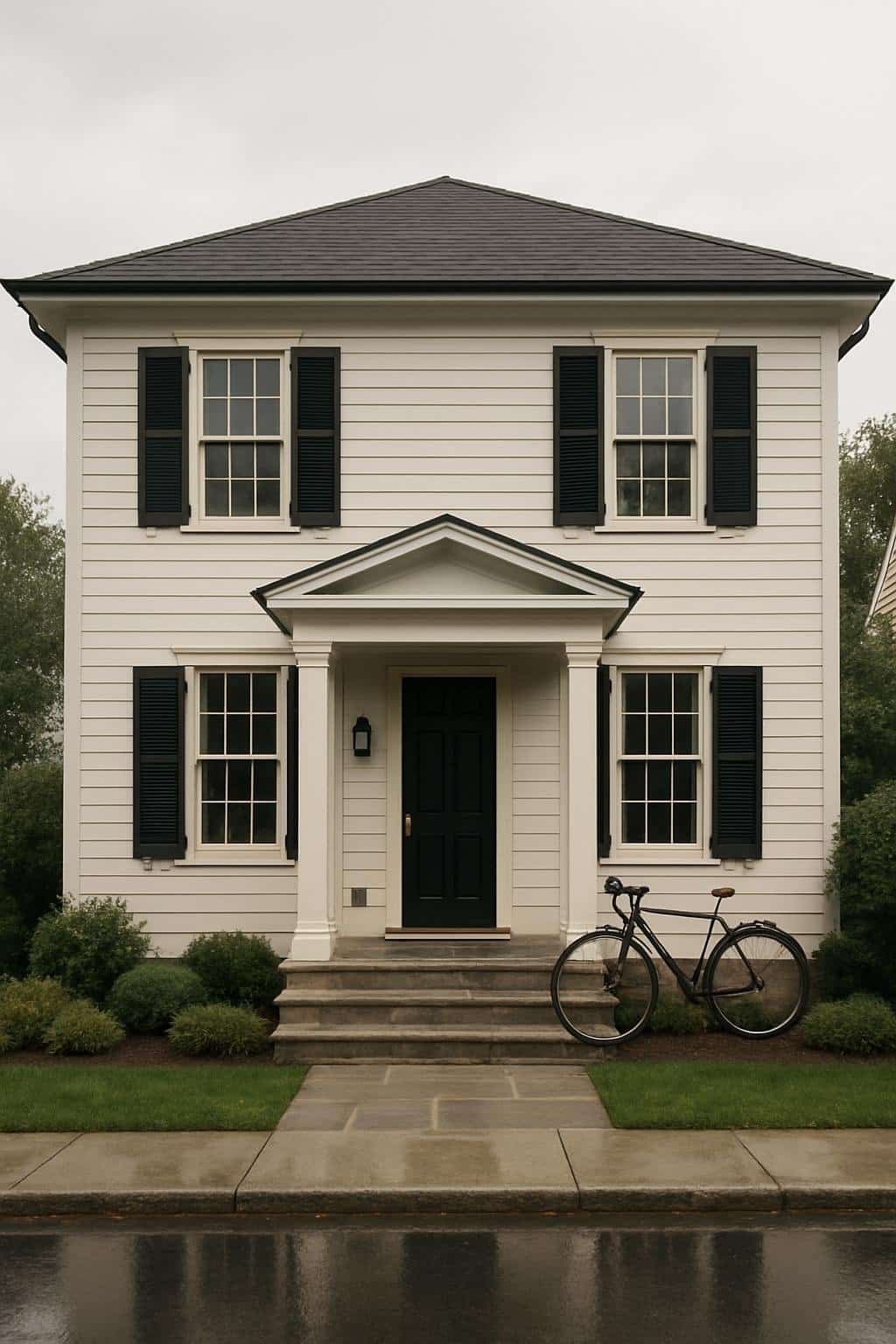
Pairing a soft white exterior with a dark roof creates a balanced and timeless look. Small details such as shutter color and the effect of weather on materials influence how the home feels from the street.
Alabaster siding with slate roof creates balance
Alabaster by Sherwin-Williams works well with slate roofing because its warm undertone softens the contrast against the roof’s cooler gray tones. This pairing avoids the starkness that bright whites can create, instead producing a cohesive and inviting exterior.
The muted warmth of Alabaster keeps the home from appearing too cold or sterile. At the same time, natural slate provides depth and durability, grounding the light siding with a stable, long-lasting material.
When viewed together, the siding and roof create a balanced palette that complements landscaping and hardscaping. The neutral base also makes it easier to introduce accent colors through trim, shutters, or doors without overwhelming the design.
Key qualities of this pairing:
- Warm off-white siding softens the exterior.
- Slate gray roof anchors the design.
- Balanced contrast avoids harsh edges.
Black shutters add classic definition
Adding black shutters to an Alabaster and slate exterior provides structure and definition. The shutters frame windows, drawing the eye to architectural details and preventing the light siding from feeling washed out.
Black is a traditional choice that works with both historic and modern house styles. It stands out against Alabaster without clashing, offering a crisp edge that emphasizes proportion and symmetry.
This element also ties visually to the roof, creating a link between the upper and lower parts of the house. The result is a layered look where each feature—roof, siding, shutters—contributes to a cohesive whole.
Benefits of black shutters:
- Highlight window placement
- Add depth to light exteriors
- Connect visually with the roof color
Cloudy rain-washed pavement adds realism
A freshly rained-on driveway or walkway changes how exterior colors appear. Wet pavement darkens, reflecting cooler tones that contrast with the warmth of Alabaster siding. This effect makes the house look grounded and realistic, especially when paired with a slate roof.
Cloudy skies further shift the perception of color. Without direct sunlight, Alabaster leans more muted, while the slate roof appears slightly darker and richer. The combination feels natural and understated, avoiding glare or overly bright contrasts.
Designers often consider how weather impacts curb appeal because homes rarely exist in perfect light. Rain, overcast skies, and damp surfaces highlight textures and subtle undertones that might otherwise go unnoticed.
Visual effects of wet pavement:
- Darker surface enhances contrast
- Reflections create depth
- Complements muted siding and roofing tones
Golden Hour On Navy Shutters
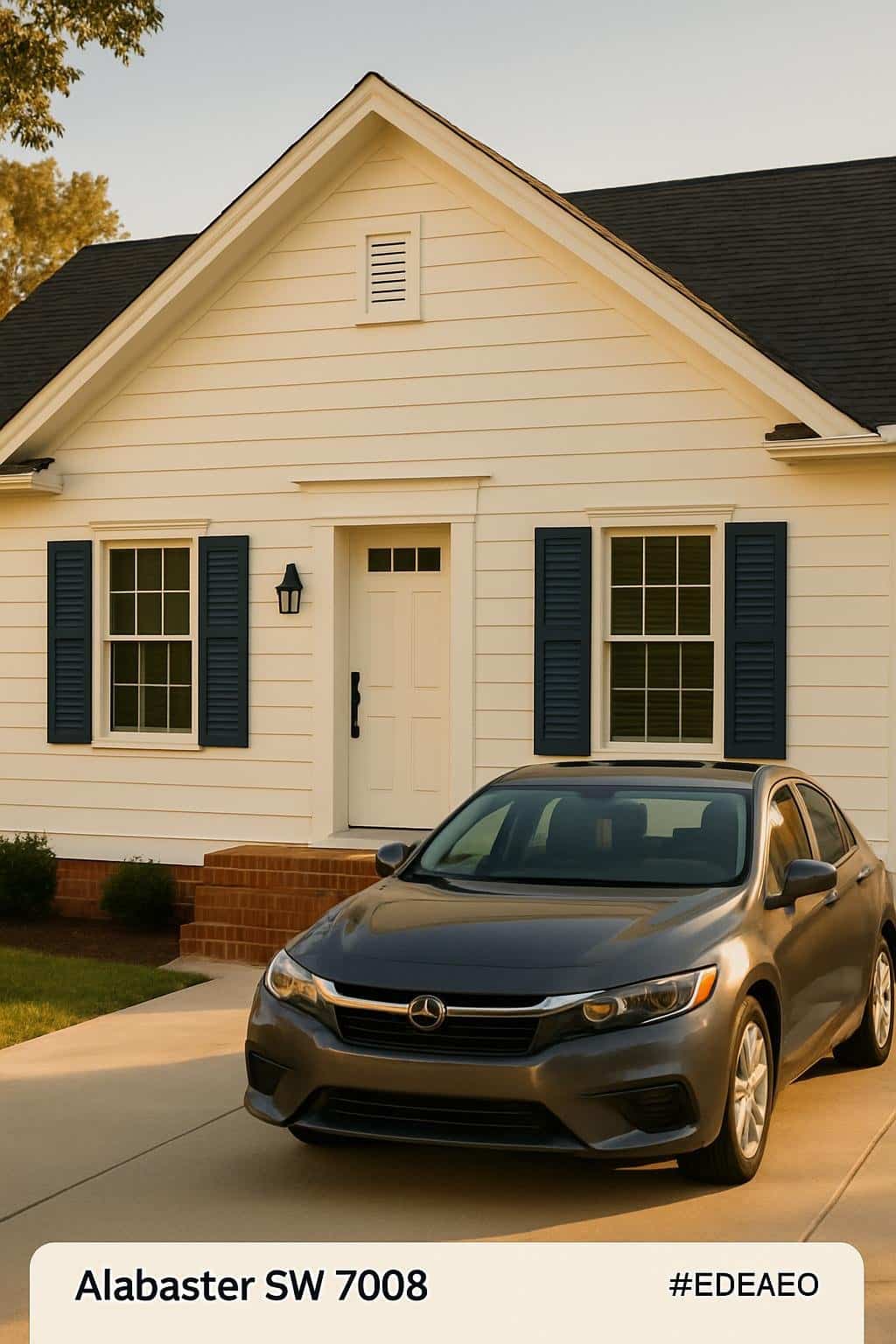
Pairing Alabaster siding with navy shutters creates a balanced exterior that feels both crisp and timeless. The addition of a dark gray roof anchors the palette, while the warm cast of late-day sunlight softens the contrast and highlights architectural details.
Navy shutters pop against Alabaster siding
Navy shutters stand out clearly when set against Alabaster, a soft white with a slightly warm undertone. This combination avoids the starkness of pure white, allowing the deep blue to read as bold but not harsh.
The contrast works especially well on homes with symmetrical facades, where shutter placement frames the windows and adds rhythm to the design. Even simple trim details gain more definition when the shutters provide a darker outline.
Designers often recommend navy, such as Benjamin Moore Hale Navy, because it maintains depth without appearing flat. When paired with Alabaster, the shutters highlight the siding’s subtle warmth, producing a clean but approachable look.
Key pairing benefits:
- Strong contrast without overwhelming brightness
- Works with both traditional and coastal styles
- Enhances architectural lines around windows
Dark gray roof grounds the palette
A dark gray roof complements the Alabaster and navy combination by providing a neutral anchor. Without this grounding element, the contrast between light siding and dark shutters could feel top-heavy or incomplete.
The roof color ties the palette together by echoing the depth of the shutters in a broader surface area. This creates visual balance across the elevation and prevents the shutters from appearing isolated.
Gray also offers flexibility. It blends with stone accents, concrete driveways, or metal details, helping the overall design remain cohesive. Unlike black, which can appear severe, a medium-to-dark gray softens the transition between the siding and the roofline.
Roof pairing notes:
- Charcoal or slate gray works best with navy accents
- Avoid overly warm browns that may clash with Alabaster
- Matte or low-sheen finishes reduce glare in bright light
Golden hour glow warms the entire facade
During golden hour, the low sun casts a warm light that enhances the natural undertones of Alabaster siding. The subtle creaminess in the paint becomes more noticeable, giving the home a softer and more welcoming appearance.
Navy shutters also benefit from this light. Instead of appearing flat, they reveal depth and richness, with highlights along edges and recessed panels. This variation prevents the shutters from looking too heavy against the light-colored walls.
The dark gray roof shifts slightly warmer under the same glow, creating harmony across the palette. Together, the siding, shutters, and roof appear more cohesive, with the natural light acting as a unifying filter.
Visual effect at golden hour:
- Alabaster siding reflects soft light instead of glare
- Navy shutters gain dimension and subtle sheen
- Gray roof tones blend seamlessly with both elements
Brick Foundation With A Neutral Glow
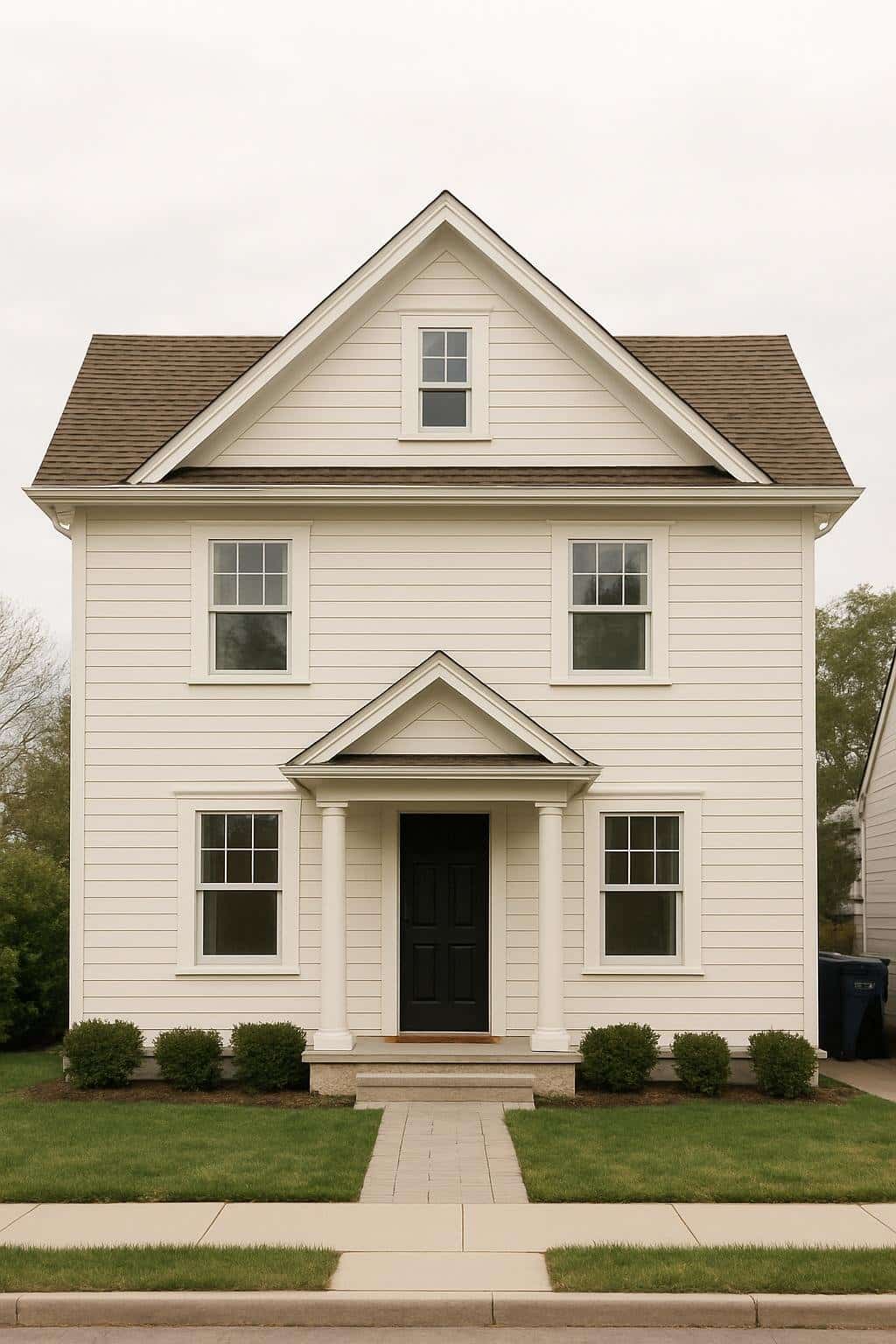
An Alabaster-painted home gains depth and balance when paired with a natural brick base. The combination highlights texture, creates visual grounding, and maintains a timeless look that adapts well to changing light conditions.
Brick foundation adds earthy grounding
A brick foundation introduces warmth and stability to an Alabaster exterior. The natural variation in brick tones—ranging from soft beige to sandy tan—anchors the home visually and prevents the white paint from feeling stark.
This grounding effect works especially well on homes with multiple stories, where the lower level benefits from added weight and definition. The brick also provides durability against weathering, which makes it both a practical and aesthetic choice.
Homeowners often select lighter blonde or buff bricks to complement Alabaster. These shades avoid harsh contrast while still offering enough texture to keep the design interesting. When combined with clean landscaping edges or stone pathways, the result is cohesive and understated.
White trim keeps the look crisp
Trim painted in a true or slightly warm white reinforces the clean appearance of Alabaster siding. By framing windows, doors, and rooflines, the trim separates the brick foundation from the painted surfaces, ensuring the transition feels intentional rather than abrupt.
Subtle differences in paint choice matter here. A color like Sherwin-Williams Alabaster on the main body pairs well with a brighter white trim such as Benjamin Moore Chantilly Lace for contrast, or a softer white like Creamy for a more blended effect.
Key considerations for trim selection:
- Match undertones to avoid clashing with brick warmth
- Use satin or semi-gloss finishes for durability and definition
- Keep consistency across all trim for a unified look
This approach maintains crisp lines that elevate curb appeal without overwhelming the brick’s natural texture.
Cloudy daylight softens the palette
Lighting conditions influence how Alabaster and brick appear together. On overcast or cloudy days, the colors take on a muted, diffused quality that reduces glare and emphasizes the subtle undertones in both materials.
The brick’s earthy warmth becomes more noticeable, while the Alabaster shifts toward a gentle, creamy white. This balance creates a calm, inviting appearance that feels less stark than in direct sunlight.
Homeowners should consider how their exterior reads at different times of day. For example:
| Time of Day | Effect on Palette |
|---|---|
| Morning Sun | Brighter contrast, sharper edges |
| Midday Sun | Strongest white appearance |
| Cloudy Light | Soft, blended tones, reduced contrast |
This awareness helps ensure the chosen scheme looks appealing in all conditions, not just at peak daylight.
Garden Hose By A Tan Roofed Home
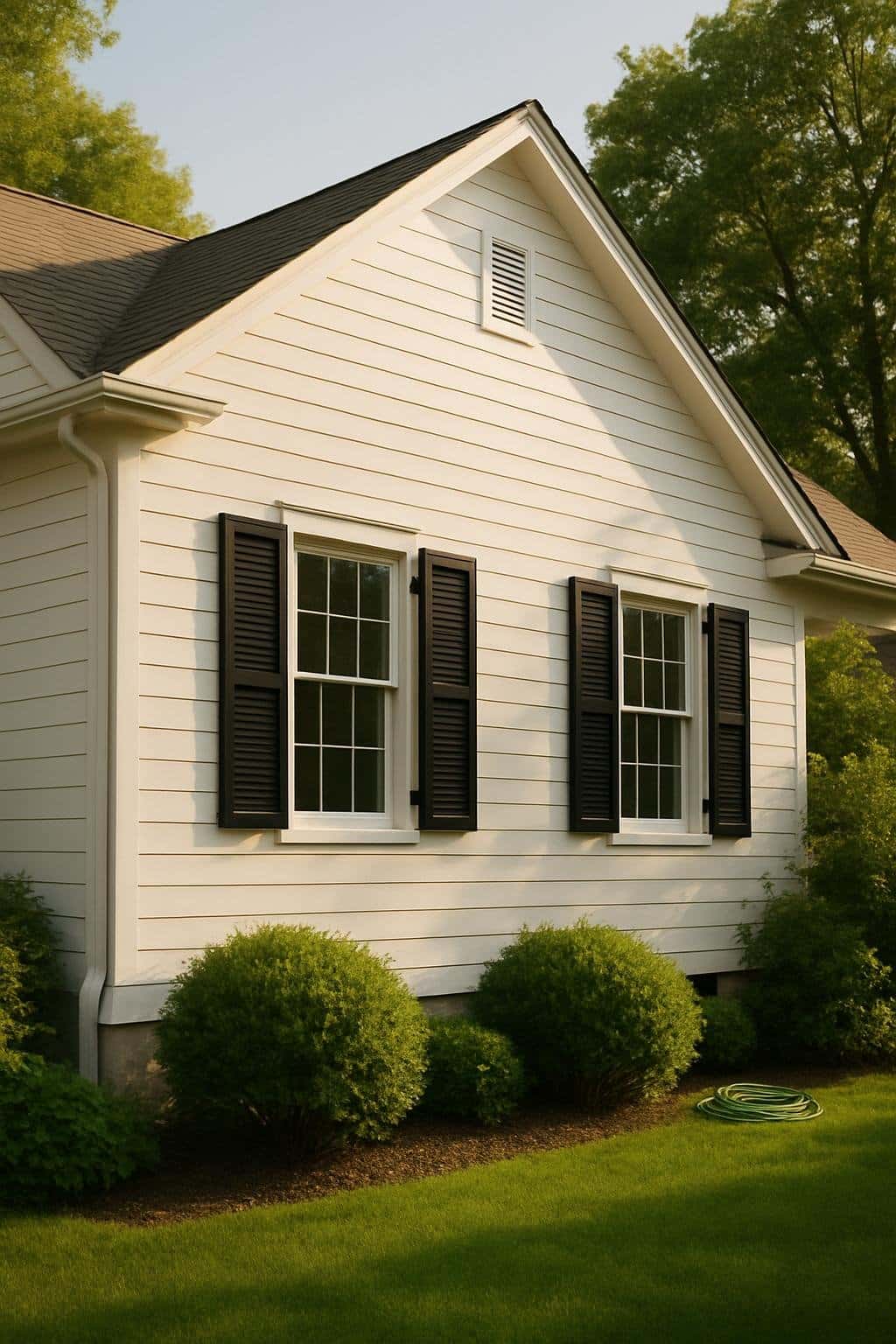
The combination of a tan roof and alabaster siding creates a balanced exterior that feels both warm and clean. Small details such as shutter color and how light interacts with the surfaces influence how the home is perceived from the street.
Tan roof warms the Alabaster siding
A tan roof introduces a natural warmth that offsets the cooler undertones of alabaster siding. This pairing prevents the exterior from appearing too stark or washed out. The earthy roof color brings depth, making the siding look brighter and more defined.
Homeowners often choose darker tan or medium brown shingles because they complement alabaster without overwhelming it. This balance works well in neighborhoods where neutral tones are common but variety is still desired.
Key considerations:
- Roof tone: Medium-to-dark tan adds contrast.
- Siding undertone: Alabaster leans soft white, so warmth is needed.
- Durability: Tan shingles tend to hide dirt and weathering better than lighter shades.
This combination creates a steady backdrop for landscaping and other exterior accents.
Black shutters add sharpness
Black shutters provide a crisp outline against alabaster siding and a tan roof. The contrast is noticeable but not overpowering, giving the home a more structured appearance. This works especially well on traditional or colonial-style homes where symmetry and definition matter.
Unlike softer accent colors, black shutters remain versatile. They coordinate with a wide range of front door colors, from wood tones to muted blues or greens. This flexibility makes them a practical choice for homeowners who may want to update other details later.
Advantages of black shutters:
- Strong visual contrast with alabaster
- Works with both warm and cool roof tones
- Low maintenance compared to lighter-colored shutters
The sharpness they add ensures windows stand out as intentional design features rather than blending into the siding.
Evening light highlights everyday details
As evening light shifts across the facade, alabaster siding reflects soft tones while the tan roof absorbs warmth. This creates a subtle gradient effect that makes the home look more dynamic at different times of day.
Shadows from shutters, trim, and rooflines become more pronounced in low light. These details add character without requiring additional design elements. A simple garden hose coiled near the base of the siding even becomes part of the lived-in aesthetic, blending into the natural light and shadow.
Positioning outdoor lighting near the entry or landscaping enhances this effect. Warm LED fixtures, for example, highlight the contrast between alabaster siding, tan shingles, and black shutters. This layered lighting approach keeps the home visually appealing after sunset.
Green Shutters And A Child’s Bike
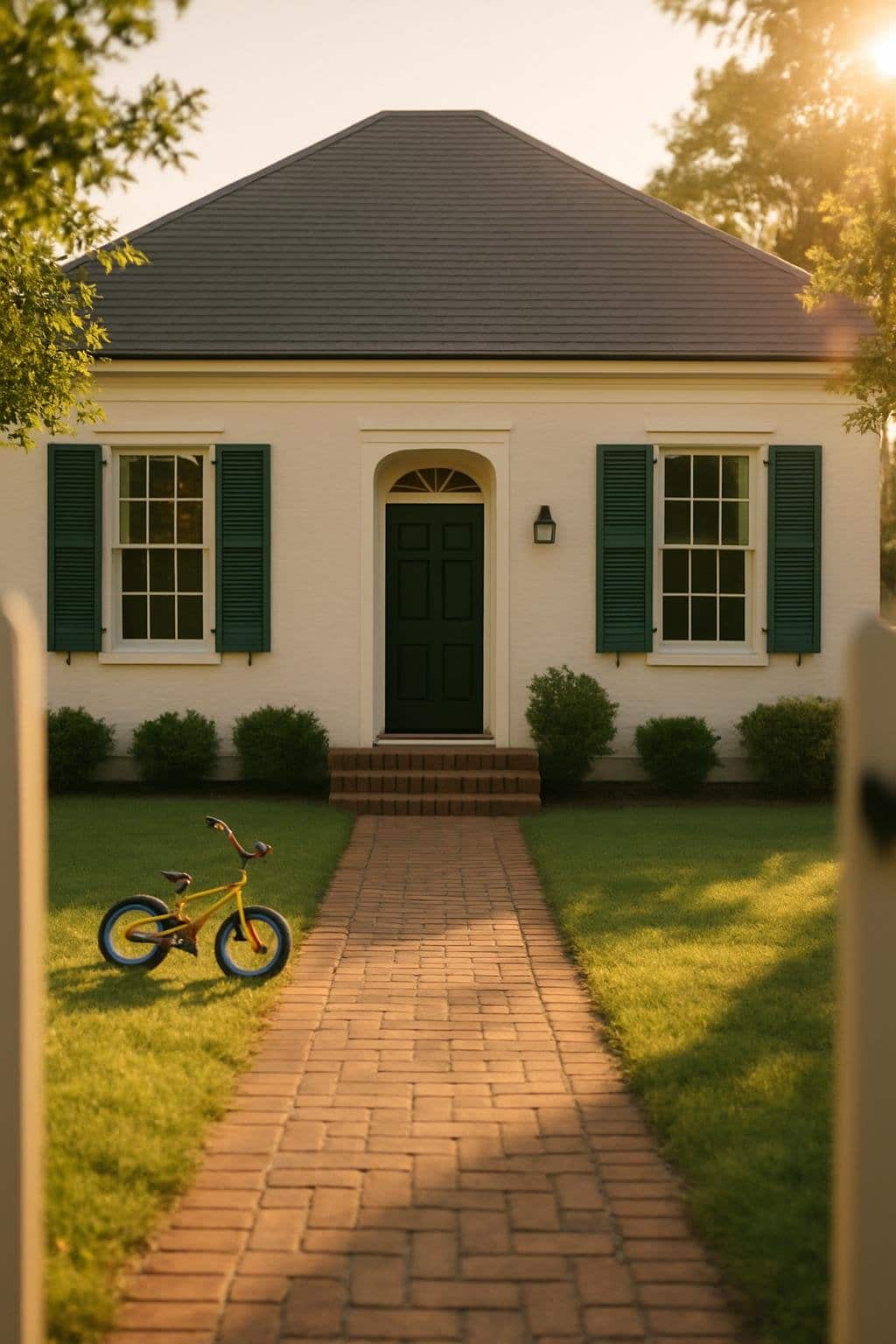
Alabaster siding pairs well with natural tones and subtle contrasts. Small details like shutter color, roof shade, and even the presence of everyday objects create a balanced and approachable exterior.
Forest green shutters complement siding
Forest green shutters provide a strong but natural contrast against alabaster siding. The deep tone works especially well because it avoids clashing with the light warmth of alabaster, instead creating a crisp outline for windows.
This pairing also fits a range of architectural styles, from traditional colonials to modern farmhouses. The shutters act as an anchor, preventing the light siding from appearing washed out in bright sunlight.
For homeowners, the benefit lies in flexibility. Forest green pairs easily with muted landscaping tones such as boxwood hedges or darker mulch. It also works with both brass and black hardware, giving freedom in selecting door handles, lighting, and railings.
A simple table illustrates combinations that maintain balance:
| Element | Recommended Finish | Effect |
|---|---|---|
| Shutters | Forest Green | Creates contrast |
| Trim | Extra White | Brightens edges |
| Front Door | Natural Wood or Black | Adds focal point |
| Landscaping | Dark Mulch | Grounds the palette |
Charcoal roof adds depth
A charcoal roof helps tie the alabaster siding and green shutters together by adding a darker upper frame. Without this depth, the siding and shutters may appear disconnected, especially in homes with multiple stories.
Charcoal tones provide a neutral base that works with warm and cool accents. Unlike lighter roofing, which can make the home appear top-heavy, charcoal balances the weight of the façade.
This choice also improves long-term practicality. Darker roofs often hide debris and weathering better than lighter shades. For curb appeal, the result is a cleaner and more uniform look over time.
Pairing charcoal with green shutters avoids the risk of competing undertones. The result is cohesive rather than busy, which is particularly important when the design aims for understated charm.
Golden hour lens flare adds lived-in charm
The presence of a child’s bike near the entryway can shift the perception of the home from staged to lived-in. When sunlight catches the bike during golden hour, the effect emphasizes warmth and daily life.
This detail does not rely on major design choices but on timing and placement. A bike leaning casually against the porch rail or resting on the driveway signals activity without clutter.
Photographs taken at this time highlight both the alabaster siding and the green shutters with soft shadows. The bike becomes an accent that adds scale and relatability.
Small lifestyle elements like this make the home feel approachable. They remind viewers that design choices are meant to support real living, not just visual presentation.
Closing
When homeowners choose Alabaster as the main exterior color, they gain a versatile base that works with both light and dark accents. It provides a soft, creamy backdrop that avoids looking too stark or too yellow.
Pairing Alabaster with the right trim and accent shades is key. Some combinations lean modern, while others highlight a more traditional style. Each scheme changes how the home feels from the street.
Examples of balanced pairings include:
- Alabaster + Black shutters + Natural wood door
- Alabaster + Light gray trim + Dark gray roof
- Alabaster + Green accents + White trim
A quick reference table helps illustrate how these pairings influence curb appeal:
| Base Color | Trim/Accent | Effect on Style |
|---|---|---|
| Alabaster | Black | Clean, modern |
| Alabaster | Gray tones | Subtle, refined |
| Alabaster | Green/wood | Warm, natural |
Because Alabaster is a neutral with warmth, it adapts easily to different surroundings. In neighborhoods with varied architecture, it blends without looking flat. In newer builds, it can soften sharp lines and make the home feel more inviting.
By selecting complementary accents, homeowners ensure that Alabaster does not stand alone but instead works as the foundation of a complete exterior palette. This balance helps the home appear cohesive and well thought out.

